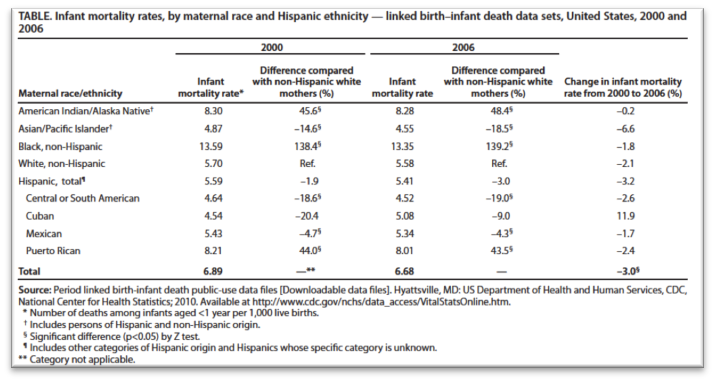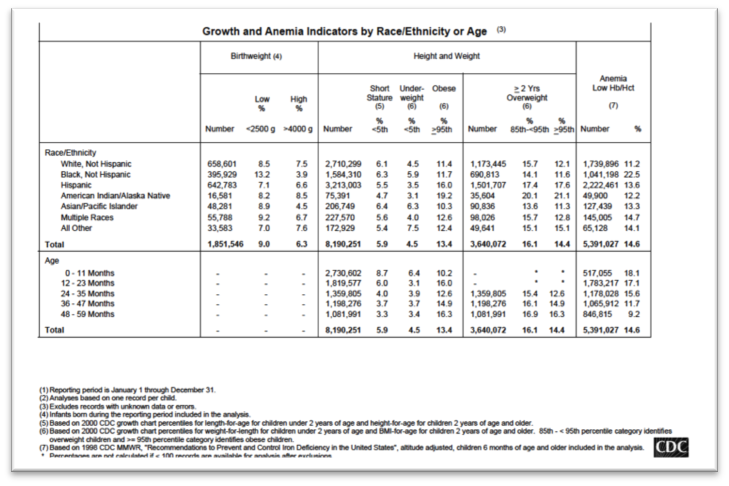Southern Anatolia is 64.4% Kurdish while parts of Eastern Anatolia are as much as 79.9% Kurdish; all other regions of Turkey are less than 10% Kurdish, making Southeastern and Eastern Anatolia significantly Kurdish in comparison. A survey that differentiates people of Southeastern and Eastern Anatolia from people of other regions can therefore be used to differentiate Kurdish and Turkish health.
Health Surveys
The United States Centers for Disease Control and Prevention (CDC) is charged with the task of “reducing gaps between the least and most vulnerable U.S. residents in illness, injury, risk behaviors, use of preventive health services, exposure to environmental hazards, and premature death”(CDC 2011). The CDC therefore examines a variety of factors including socioeconomic status to better understand domestic health disparities. The CDC’s most recent survey data was produced in the Health Disparities and Inequalities Report. This report separated groups by race and examined different health factors to locate inequalities. This data will be a good comparison to that of the TDHS.
The Turkish Demographics and Health Survey (TDHS) is a set of statistical health data that has been collected every five years since 1968. It focuses on mother and child health, the stated top priorities of the Turkish Ministry of Health (TUBITAK 2008) and is therefore a reasonable survey for examining health disparities within Turkey. The survey categorizes respondents into 5 regions: North, South, East, West and Central. North contains the Black Sea region; South consists of the Mediterranean region; West contains the Marmara and Aegean regions; East consists of Southeastern Anatolia and Eastern Anatolia; and Central consists of Central Anatolia (TUBITAK 2008). As previously discussed, the Kurdish people are heavily concentrated in Southeastern and Eastern Anatolia, therefore the East region can be closely associated with Kurds for the purposes of analyzing survey data. This survey will represent the Turkish health situation.
Comparison of Health Disparities in Turkey and the United States
Infant Morality Rates
The Untied States by Race
Disparities in infant mortality rates exist in America. In the 2000 and 2006 CDC survey, Blacks reported infant mortality rates double those of other racial groups (with the exception of Native Americans). The CDC attributes these inequalities to discrimination, stress, and socioeconomic status; however, the role of economic status should not be overestimated. Hispanics, who share similar socioeconomic status and residence to blacks (Crimmins) – having comparable access to education, health facilities, and income – have much lower mortality rates than blacks. In fact, hispanic infant mortality rates are comparable to those of whites. This suggests that economic status does not necessarily prevent proper health, instead, other factors might play more significant roles. With this in mind, the discrimination, stress, and other non-economic barriers must not be overlooked when evaluating the United States and Turkey.
Turkey by Region
Interestingly, Turkey exhibits regional disparities that are comparable to American racial disparities when it comes to infant mortality rates. The data from the TDHS survey depicts the average number of infant and under-five deaths per one thousand that occurred within the ten-year period preceding the survey (as reported by respondents). The results illustrate higher rates of infant and child mortality in the East than in other regions. The East’s under-five mortality rate is nearly double that of the West, Central and North regions, and remains nearly one and a half times that of the Southern region. The discrepancy in infant mortality rates in Turkey is therefore comparable to those of the United States, a historically discriminatory nation.
Growth and Anemia Rates
The United States by Race (Growth and Anemia)
This survey data depicts two areas where blacks face health discrepancies: birthweight and anemia. According to these survey results, black babies are one and a half times more likely than people from other groups to be born underweight. Reasons for underweight birth include: lack of iron, stress, lack of neonatal vitamins (BabyCenter). Therefore the lower birthweight of black babies can be directly correlated to their higher rates of anemia (also by a factor of 1.5)(CDC 2012).
Previous scholarly material on this subject has found that pregnant Black women are less likely to receive instructions about alcohol or drug use, among other basic guidelines, by their doctors (Kogan). This has proved to significant evidence of racial discrimination as a patient’s socioeconomic background, culture, or region of inhabitance should not affect the ability of a professionally trained doctor to relay important (and basic) medical information to her.
Turkey by Region (Potential for Anemia)
This survey asked respondents, who had received antenatal care, what components were implemented by their healthcare providers, including whether or not they were given iron tablets. Iron tablets are a basic component of antenatal care. Women require twice the amount of iron during pregnancy, so nearly all pregnant women require iron tablets to ensure the health of their newborns (Food and Agriculture). Side effects from not taking iron tablets could include lower infant birthweight, higher chance of infant anemia, and higher chance of stillborn or newborn death (Baby center). Respondents from the East were significantly less likely to receive iron tablets than those from the other regions – East (61.2%), West (85.6%), South (82.6%), Central (87.1%), North (82.6%). This means that they are at a higher risk for infant mortality, anemia, and lower birth weights, the three health concerns that black babies are most likely to face in the United States.
Conclusion
Regional health disparities in Turkey are consistent with those of racial health disparities in the United States, suggesting the possibility of regional (Kurdish) discrimination in Turkey on a comparable level to racial discrimination in the United States. This statement argues that the Kurdish people are a marginalized group facing similar effects of discrimination to blacks in the United States. The drawback with this conclusion is that it relies on region as a proxy for ethnicity.
Despite the fact that region is closely correlated to ethnicity in Turkey, it is not a perfect substitute. Regional discrepancies could be based in non-ethnic circumstances. For example, eastern regions of Turkey are typically mountainous and isolated. Therefore remoteness could be a reason for reduced health. This does not explain the entirety of disparities, as the “Rural” category would need to be identical to the “East” category in that case; instead, the East trails behind the “rural” category in each health metric. Regional access to resources could be a factor in disparities, but is not sufficient for explaining all of them. Non-ethnic regional culture, economics, and knowledge are all additional factors that could explain regional health disparities.
Ultimately, the only way to be certain that ethnic health discrimination exists would be to identify ethnic groups and compare their health results directly. Until this occurs, regional discrepancies can only speculate ethnic discrimination.





